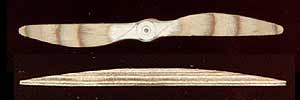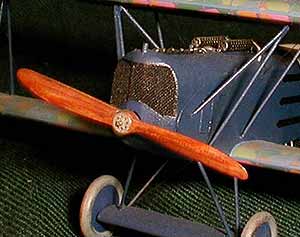How to Carve Propellers from Wood
(Alternatively titled: I am a Sad, Sad Bastard) |
| People are constantly coming up to me on the street and asking, "Gosh
Andy, how the heck do you carve those little wooden propellers on your WW1
aircraft?" Why, just the other day Richard Branson, always on the look
out for new and money saving methods of propulsion for his Virgin fleet,
asked the very same thing. "Well Dick", I said, "here's how
it's done:" |
| Step 1: Wood & Plans |
| I like to use the thin plywood found in the flying models section of
the hobby shop. 1/32" ply works well for 1/72nd scale and 1/16"
ply suits 1/48th. I haven't tried this in larger scales (yet) but it would
probably be better to get some of the thin veneer used for ship models
and laminate several pieces together for 1/32nd scale and up. I work mostly
in 1/72nd but the method is the same for any scale. The example in the
photos is a Sopwith Camel prop done to 1/48th scale so it would be easier
to see. |
| Cut two (or more in larger scales) rectangular pieces of wood slightly
larger all around than the finished prop will be. Cut one piece with the
grain of the wood and one piece across the grain; this will give you 6
alternating layers as each piece of plywood is made up of three layers.
If cutting multiple pieces for larger props I would cut them all with
the grain but use three pieces each of two different types of wood to
give a nice laminated look, like the full size propeller. Laminate the
wood together with whatever glue you prefer. Strangely enough, wood glue
seems to work quite well. It's best to clamp the wood in a vise while
the glue is drying to get a good bond as having a split appear in the
propeller later is rather annoying. |
Next, find a good set of plans of the aircraft you're building. These
usually have front and side views of the prop. You may have to size the
plans with a photocopier to fit the scale you're building in. Make a copy
of the plans (copyright laws allow you to make one copy for your own personal
use, in case anybody gives you a hard time about this) as you will need
to cut them up and I assume you wouldn't want to sacrifice the original.
Cut out the front view of the propeller and glue it to your previously prepared
wood blank. At this point you should have something like this: 
|
| Step 2: Carve that monkey, Bubba |
This is where the fun begins. Carve away anything that doesn't look like
a propeller. I usually rough this out with a coarse sanding drum on the
trusty old Dremel moto-tool which makes short work of it. Take it down
to within about 1/32" of the line and then use files and sandpaper
after that. Accurate carving here will make life much simpler later when
the final shaping is done so take your time and ensure that the blades
are symmetrical and the hub is round and well defined. Also, try to keep
everything squared up, that is, keep the sides at 90 degrees to the front
and back - you're just carving a flat blank at this stage so don't worry
about the ultimate shape of the blades. All going well, it should start
looking like a propeller, from the front anyway:
|
This is where the side elevation comes in. Carving the proper taper in
the blades is what will give the correct twist later. It isn't practical
to glue a copy of the side view on the prop so just keep referring to
it as you carve. Again, I rough this out with the Dremel and finish up
with files and sandpaper. So far, this is what the propeller looks like
from the front and side:  |
Alrighty then. Still with me? Hello...?! Hey, wake up - this is where
it gets really interesting! Carving the final blade shape. I switch to
a sharp hobby knife here. A brand new blade is best, otherwise
you'll be getting all sorts of splintering and gouging happening (possibly
in your own hand if the knife slips) which is just plain unattractive.
Basically, you want a nice airfoil shaped blade - curved on the front
and flat on the back - so keep that in mind when carving. Take small amounts
off with each cut rather than try to do it in a couple of big slices which
would be a sure fire method of breaking the prop or carving off more than
you meant to. The blades will be surprisingly strong even in 1/72 scale
but it wouldn't take a lot of pressure to snap them. After the basic shape
is roughed out with the knife use 320 grit sandpaper to finish shaping
and then switch to finer grades for the final finishing. Here's what you've
got, right?!? 
|
| Step 3: Finishing, bragging to your cat about your amazing woodworking
abilities, etc., etc. |
A final sand with 600 grit sandpaper to smooth everything out and then
finish off however you like. I use a thinned brown enamel for a stain
followed by another light sanding with 600 or 1000 grit to bring out the
grain. Finish off with a couple of coats of gloss clear, a photo etched
prop boss and a bit of stainless steel tubing for the shaft and you're
done.
And ta-da!!! Here it is:
Note I didn't have any photo etched prop bosses in 1/48th scale thus the
lack of one in the pic.
Here's a 1/72nd scale prop on Revell's D.VII for a better idea:
|





